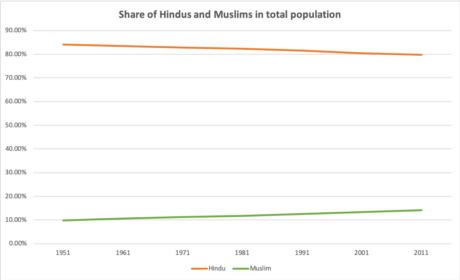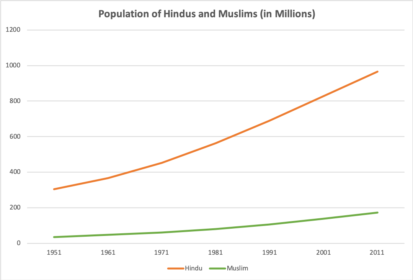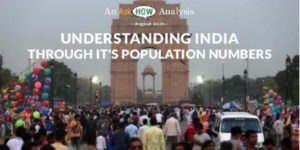The proposed UP population law will not achieve its aim but it is not easy to dismiss underlying concernsfeatured
The government of Uttar Pradesh (UP) has proposed a new law to ‘stabilize’ the population of the state by providing ‘incentives and disincentive’. Many commentators have alleged that the law has been proposed to drive a wedge between Hindus and Muslims. They further imply that that the demographic anxiety of Hindus is misplaced. I believe that there are surer ways of reducing fertility than this law, if that is indeed the aim. However, I would not be too quick to dismiss the demographic anxiety as irrational.

Representational Image by Gerd Altmann from Pixabay
The proposed law has a long list of incentives for a couple with two children or less and another long list of disincentives for couples who have a third child. In my view, these incentives target a very small section of the population and more importantly, many of them are difficult to implement. Are there better options?
Let us start by looking at what is happening to fertility in India and UP.
India as a whole is already near replacement level of fertility
The Sample Registration System (SRS) found that in 2017, the Total Fertility Rate (TFR) of India was 2.2. The replacement fertility rate is generally considered to be 2.1. Some scholars believe that given the low Sex Ratio at Birth in the country, even a total fertility rate of 2.2 may be replacement rate. In any case, the country is at or near the replacement rate fertility. The TFR in UP is higher than the national average. In 2017, it was 3.0. But it has been reducing for the last few decades. Will it come down further? If yes, how?
As I have covered in this piece, fertility depends a lot on childhood mortality. A sharp fall in fertility happens when couples know that their children have a high likelihood of survival. Additional falls in fertility happen with factors like urbanization and women’s education. If UP is concerned about population growth, then it should focus on maternal and child health. And it should focus on urbanization and women’s education and empowerment. These are sure ways of reducing future population growth.
I must note here that the population growth in a society continues till long after the fertility has reached replacement rate. This is because most of the people in such a society are young. As they marry and have their 2.1 children, the number of births in that society are way more than the number of deaths as the aged people group is much smaller. I have explained this topic here. The population of UP is expected to increase for many decades even as its fertility falls and the law cannot change that.
But what about the subtext, you ask? Many people have suggested that the proposed law in Uttar Pradesh has less to do with overall population growth and more to do with growth in Muslim population. Let us take a look at the issue next.
Islam and population growth in India
My piece on this topic was one of the most read posts that I have written. I began with these two charts.


As these charts show, the share of Muslim population in India has grown since independence. This is because the growth rate of Muslims is higher than that of non-Muslims. The table below gives the decadal growth rates.

However, the charts show that there is no chance of India becoming a Muslim majority country. Especially as the growth rate for both communities is reducing.
Moreover, data also shows that there is nothing inherently in Islam that leads to a very high rate of growth of population. Many Islamic countries have a low fertility. For example, the Islamic Republic of Iran had a fertility rate of 2.1 in 2017 as did Bangladesh. Even in Pakistan and Afghanistan the fertility has fallen sharply. The fertility in the erstwhile state of Jammu and Kashmir was 1.6 in 2017. It should be remembered that the population in J&K is majority Muslim. Sharp reduction in fertility happens in Islamic societies with sharp fall in childhood mortality and with increase in urbanization and women’s education and empowerment. Just like it happens in non-Islamic societies.
If there is no chance of Muslims becoming more than 50% of population of the country, why is there a fear in many circles of increase in share of Muslims? If the critics of the UP law are correct, the law has been probably been proposed to exploit this fear. Is this fear baseless?
Not so fast.
Democracy and demography
People vote on the basis of their identity. Not everyone but many people.
Identity is a complex thing but in our country two identities that are strongly associated with political preferences are caste and religion. Very crudely speaking, in many states, one side emphasizes the caste identity and the other stresses on the religious identity. In a few parts of the country — Mumbai and Delhi for example — the regional identity also becomes important. An increase in the share of population of any of these identities is concerning for people of the other identities and legitimately so. The number of votes win an identity power. And with power comes jobs, benefit and prestige.
Incidentally, identity is not just important in Indian democracy. Here is the then presidential candidate of United States, Joe Biden of Unites States saying that “If you have a problem figuring out whether you are for me or Trump, you ain’t black.” Politicians across the world emphasize identity because it works.
The exemplar of the importance of identity in India would be Assam. The demographic history of Assam is very complex. For the purposes of our discussion here, we can say that three voting blocks have tussled in Assam over the last many decades. They are the non-tribal native Assamese, Bengali speaking Muslims and Bengali speaking Hindus. The Bengalis speaking Muslims and Hindus migrated to the state over the last hundred and fifty years. Migrants and their descendants probably comprise more than 50% of the population of the state now. The state has seen many identity coalitions over the past decades. For example, at one time, the native Assamese were in coalition with Bengali speaking Muslims but they then got alarmed by a sharp increase in the number of Bengali Muslim voters
The share of Muslim population in Assam has steadily increased from 24% in 1971 to 34% in 2011. Many constituencies have become Muslim majority. There is dispute about whether immigration or higher fertility of Muslims is the cause of this change but there is no doubt in that this demographic change impacts power dynamics. To understand this issue more, you could read this compact piece.
Religion based demographic changes are not the only ones that lead to shift in power. Differences in fertility across regions can also change power dynamics. Northern states — with their higher fertility — have a higher share of population today than they did fifty years ago. However, their share of political power has stayed the same. Uttar Pradesh elects 80 Members of Parliament and Tamil Nadu elects 39 as they did in 1977. This is when the population of UP (231 million) has increased much more than the population of TN (71 million). Remember, each MP has an equal say in electing the Prime Minister of the country. I am sure that in my life time, people of UP (and other North Indian states) will agitate for a more equitable share of power and people from TN (and other Southern and Western states) will oppose it claiming that they’re being penalized for becoming more prosperous faster.
Here is the problem in a nutshell. Some identities have higher growth rates — many times because they are poorer. This higher growth rate leads to more votes and hence power in the hands of those identities. This is almost inevitable in a democracy.
This is a complex problem with no easy fixes. However, we also know that decline in fertility inevitably follows fall in child mortality which in turn depends on prosperity. If you are an Indian and are worried about the high fertility in another religion or region, then you should at least be supporting measures that lead to prosperity of that religion or region.
Author –
Yogesh Upadhyaya
(Yogesh Upadhyaya is one of the founders of AskHow India. Blogs are personal views.)
You can follow AskHow India (@AskHowIndia) or me (@Uppi89) on twitter or me on LinkedIn or Medium. DM me if you wish me to put you on WhatsApp distribution list.



